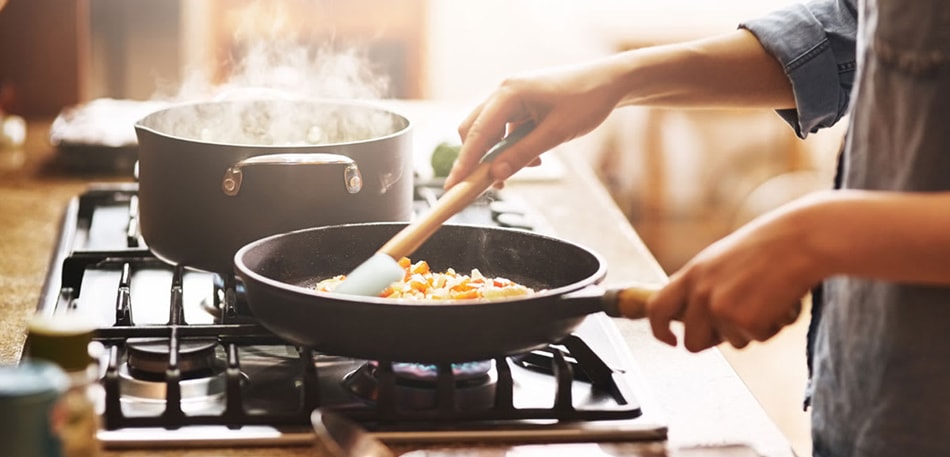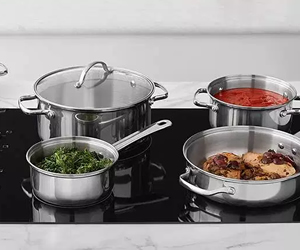
Assorted Cookware
Cooking Tools
Food preparation containers that are used in a kitchen are called cookware or bakeware. The more common ones are saucepans and frying pans which are used on a stove or range cooktop. Bakeware are the containers that are used inside an oven. There are a wide range of cookware available for sale on the open market that can be differiated by price and quality. Other cooking tools that are used by everyone from top chefs to people at home include a variety of small appliances ie. blender, food processor etc. There are also small tools like chopper, knives, spatula etc. Please click on our various links to see what each of our vendors have to offer.
Cookware Sets
To simplify your life, you may want to purchase your cookware by the set. A cookware set gives you a pre-selected collection of pots and pans without you having to individually pick the pieces you think you need. It's important to see what the set includes so that you end up getting peices that you will actually use. There are certain features that you should look for when trying to choose the best quality sets. These include materials, heat conduction, and practical features.
Remember, the 'bigger the set' does not equate to the 'better the set'. Most will probably go for the larger 15-piece cookware set, but are those pieces the ones that they will use. Not everyone needs the same size pans — a family of two people will not need what someone cooking for a family of 6 will. The best cookware sets will contain versatile pieces without doubling up on sizes that are not practical.
What pieces are included an the ideal Cookware Set?
The most useful, versatile pieces for most people who cook include the following pieces. These cover the main categories while not unnecessarily doubling up.
Small saucepan (1-2 qt)
A smal pot great for boiling eggs, small batches of grains or beans, and heating soups and sauces.
Large saucepan (3-4 qt)
A medium pot ideal for boiling/steaming veggies and making small batches of pasta.
Stock pot (6-12 qt) or dutch oven (5-8 qt)
A large pot for making stock, stews, pasta, and soups. A dutch oven is typically shorter, wider, and a bit more oval than a stock pot, and usually comes in smaller sizes.
Skillet (8-12”)
A skillet is a flat-bottomed pan with low sides that slant outwards. It is perfect for everything from scrambled eggs, sautéing veggies, frying, searing, and browning foods. They have a long handle and usually no lid. Larger pans may have a small grab handle opposite the main handle.
Sauté pan (3-4 qt)
A deeper pan with straight sides perfect for searing meat, making risotto, and whipping up sauces.
Different Types of Cookware Constuction
Depending on the type of material used to make the cookware, the cooking results will vary. The important things to keep in mind with cookware materials are: cooking surface, heat conducting core, and exterior body. Cookware for the most part has alternating layers of metals with a core of aluminum or copper to conduct the heat. More layers result in better heat distribution for cooking and durability for longevity of use. The outer layer of pots and pans are often stainless steel, aluminum, or anodized aluminum (more durable, non-corrosive aluminum through an electrochemical process), because they are lightweight and highly conductive.
Stainless Steel
Stainless steel is a non-porous metal. It heats and cools slower and more unevenly than aluminum. This material provides flavour neutrality. These pots and pans release more of the caramelized fat on the bottom of a pan. This then goes back into the sauce so it is more flavourful. Because aluminum pans are poros, light-coloured sauces may become discoloured in them. This will not happen with non-porous, non-corrosive stainless steel. Stainless steel is dent resistant and maintains its appearance well.
Aluminum
Aluminum cookware is a porous metal that can be used on both gas and electric surfaces and they heat up and cool down very quickly. Aluminum cookware is manufactured using either 1100 series or 3000 series aluminum alloys. The 1100 series is almost pure aluminum and is a soft alloy that is likely to warp and dent. The pan will become unlevel on the stove due to the warping. Unfortunately, this will causes hot spots and thus food can burn or scorch. In the 3000 series, one alloy contains aluminum, copper, iron and manganese. The other durable alloy also contains magnesium. The additional magnesium hardens the aluminum and strengthens the pan.
Carbon Steel
Carbon steel cookware is commonly used in woks. It is thinner and lighter than cast iron and it heats up quickly. This material works well with induction cooking.
Clad Cookware
Clad cookware has non-ferrous stainless steel inside and ferrous stainless steel outside. This allows it to have induction capabilities. Between these two layers are aluminum, copper or carbon steel. These materials help to reduce the heating reaction time. Clad cookware is offered in two ways - fully clad and clad bottom. Fully clad cookware spreads the heat evenly at the bottom and up the side walls. Clad bottom heats primarily at the base of the pan.



